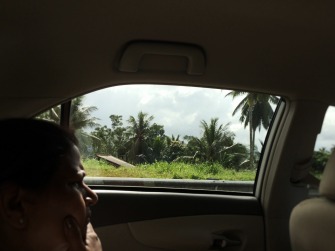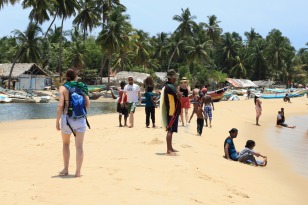Have you ever read anew a book after a long time and while skimming some of its most important paragraphs again felt like it had a whole new meaning, that you really understood the point that the author was trying to explain because some sentences of that book could now be used as a good caption to some of your personal experiences/events?
 I had this type of revelation this summer in Sri Lanka, when in my room I found a book that I had taken with me 2 years earlier to Thailand: “A Fortune-Teller Told Me: Earthbound Travels in the Far-East” by Tiziano Terzani. Without going into much detail, Terzani was an acclaimed Italian journalist, author and correspondent in East-Asia to German and Italian newspapers. While he describes his “Earthbound Travels” in South-East Asia, he reflects on the changes that are happening in the region, the process of modernization that the continent is undertaking, which in his own opinion isn’t for the better.
I had this type of revelation this summer in Sri Lanka, when in my room I found a book that I had taken with me 2 years earlier to Thailand: “A Fortune-Teller Told Me: Earthbound Travels in the Far-East” by Tiziano Terzani. Without going into much detail, Terzani was an acclaimed Italian journalist, author and correspondent in East-Asia to German and Italian newspapers. While he describes his “Earthbound Travels” in South-East Asia, he reflects on the changes that are happening in the region, the process of modernization that the continent is undertaking, which in his own opinion isn’t for the better.
In his view, Asia’s problem is that instead of following its own path, instead of looking to improve itself in its own way and on its own terms, the continent is importing the West’s way to success, slowly repressing its diversity. Because of this he believes that modernization implies Westernization, because of its incessant quest to resemble Western countries.
In his own words:
“One after another the countries of Asia have managed to free themselves from the colonial yoke and show the West the door. But now the West is climbing back in by the window and conquering Asia at last, no longer taking over its territories, but its soul. It is doing it without any plan, without any specific political will, but by a process of poisoning for which no antidote has yet been discovered: the notion of modernity. We have convinced the Asians that only by being modern can they survive, and that the only way of being modern is ours, the Western way.
Projecting itself as the only true model of human progress, the West has managed to give a massive inferiority complex to those who are not ‘modern in its image- not even Christianity ever accomplished this! And now Asia is dumping all that was its own in order to adopt all that is Western, whether in its original form or in its local imitations, be the Japanese, Thai or Singaporean.
Copying what is ‘new’ and ‘modern’ has become an obsession, a fever for which there is no remedy. (…). By now no Asian culture can hold out against the trend. There are no more principles or ideals capable of challenging this ‘modernity’. Development is a dogma; progress at all costs is an order against which there can be no appeal. Merely to question the route taken, its morality, its consequences, has become impossible in Asia.” (Terzani, :53-5)
When I first read this I understood the point that he was trying to make, but nonetheless I sensed a kind of dogmatism, a type of ‘Western conservative gaze’ that sees lands far far away as ‘exotic’ and wants them to remain as such. I believed Terzani to be one of the many old-fashioned journalists that desire Asia, Africa and South-America to remain immutable as if they were landscape paintings that depicted things that could be considered out of the ordinary European life, extremely different from what is considered normal in many Western countries, stunning but also shocking. I believed that the binary opposition between the so-called ‘West’ and ‘non-West’ was way too marked and outdated as a concept.
I mean, why should anyone now consider development, or better modernization as a negative thing?
 Ironically in perfect timing, a week later reading these lines I had the opportunity to take the infamous A2 highway in Sri Lanka as we decided to explore the Southern part of the country, which I had never visited before. Needless to say I was quite excited to see what all the fuss was about regarding this new shiny infrastructure that connected the southern cities to the capital, Colombo.
Ironically in perfect timing, a week later reading these lines I had the opportunity to take the infamous A2 highway in Sri Lanka as we decided to explore the Southern part of the country, which I had never visited before. Needless to say I was quite excited to see what all the fuss was about regarding this new shiny infrastructure that connected the southern cities to the capital, Colombo.
During all the past summers on the island, travelling to places was a completely different experience to what I was used to in Europe. Being accustomed to moving on highways in Italy, I found Sri Lankan roads questionable to say the least. Main roads connecting big cities were narrow with only two lanes, bumpy and constantly congested.
Hence, when the news arrived that they were starting to build a new high-tech highway, we were all more than pleased (little less so when we came to know that the country had indebted itself right down to the bone with China).
However, after half an hour driving on it, it felt quite bizarre. Strange because that infrastructure that I was so used to taking in Italy and  the UK, surrounded by a scenery and flora that is specific to Europe, was now replaced by palms, thick jungles, elephants, eagles and other wonderful creatures specific to the Sri Lankan island.
the UK, surrounded by a scenery and flora that is specific to Europe, was now replaced by palms, thick jungles, elephants, eagles and other wonderful creatures specific to the Sri Lankan island.
It felt plain ‘weird’ to have what I always considered as one of the most emblematic infrastructures of the ‘West’ in Sri Lanka, that clashed terribly with the rest of the country’s traditional architecture/general surroundings. But most of all, what really clashed was the A2 Highway’s symbolic wealth (its representation of grandeur) and most of the population’s actual economic status. And it wasn’t merely the highway per se but all of the various shiny new buildings and architectural projects that are planned to open in other parts of the country.
It was then that Terzani’s words came back to my mind and I truly understood his claim.
Firstly I must admi t, I am very well aware of the importance of infrastructure, I know how crucial it is for society. I acknowledge my privileged position, as well: I don’t have to go to work in Colombo, I am not a commuter who might be extremely thankful for this highway that lets him/her come back home earlier to their family, I indeed don’t have a family to feed, I don’t live in a country that constantly has to confront itself with the rest of the modernizing world. Now that I think about it, I too might have that ‘tourist gaze’ that foreigners have when they go to Sri Lanka and all they might see is the beauty of the ‘exotic’.
t, I am very well aware of the importance of infrastructure, I know how crucial it is for society. I acknowledge my privileged position, as well: I don’t have to go to work in Colombo, I am not a commuter who might be extremely thankful for this highway that lets him/her come back home earlier to their family, I indeed don’t have a family to feed, I don’t live in a country that constantly has to confront itself with the rest of the modernizing world. Now that I think about it, I too might have that ‘tourist gaze’ that foreigners have when they go to Sri Lanka and all they might see is the beauty of the ‘exotic’.
However, I can’t stop wondering if an alternative option for progress actually exits instead of modernization and Westernization. Maybe it’s too late to change now, but it’s just utterly upsetting to see so many countries succumb so cooperatively. Many places across Sri Lanka are slowly becoming photocopies of tourist cities in Thailand that mainly (or solely) cater to foreigners, suppressing small local economies and the authenticity of the areas.
I don’t understand why a country should prioritize on building lavish infrastructure or mesmerizing opulent buildings (in Colombo especially) when there still are neglected and underprivileged areas of the country (such as the many slums around the island). I know this situation is not exclusive to Sri Lanka, however it’s really hard to witness my country of origin falling into the same (long-term) undesirable patterns of other countries that only deepen the social divide. Must the whole world follow only one stream of thought?
Even now that I’m in London, various questions keep popping in my head: what does development really mean? Does ‘civilised’ necessarily imply ‘developed’? Can you be modern without being developed?
I guess that civilizations have developed or undergone processes of adaptation relative to their era in the centuries, but I’m quite certain there has never been such a rapid and vast homogenization in history. The diversity and uniqueness of different countries around the world is slowly dying. I’m just not certain whether it is for the better.

Food for thought on social media
